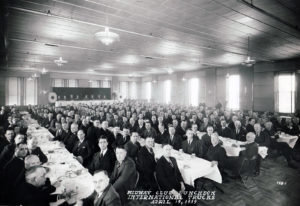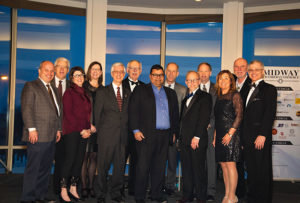 The longtime tradition of luncheon with an informative guest speaker began in 1923 and continue today. Here is a group gathered in 1939. (Photo courtesy of Midway Chamber)
The longtime tradition of luncheon with an informative guest speaker began in 1923 and continue today. Here is a group gathered in 1939. (Photo courtesy of Midway Chamber)
By TESHA M. CHRISTENSEN
One community group has been the face of the Midway area for a century. Formed in October of 1919, the Midway Chamber is celebrating its 100th anniversary this year.
First called the Midway Club and then the Midway Civic Club, the Midway Chamber of Commerce reflects the history of the Midway as a whole, observed local historian Jane McClure, who is working on a book to celebrate the chamber’s 100th anniversary. It will be available later this year.
“The Midway Chamber really shaped the growth and development of the entire area, in ways we don’t think about today,” added McClure. “Needs and issues including paved streets, the extension of streetcar lines, improved police and fire service, taxation, street lights, and jobs were among the issues the Midway Club championed. The organization brought back the Winter Carnival years before it became a citywide event again. Members worked to retain Saints baseball here and were part of the effort to attract the Minnesota Twins years ago.”
“When what was then the Midway Club began a century ago, getting things accomplished meant being organized,” McClure said. “We didn’t elect our City Council members by ward. Neighborhoods organized betterment or improvement associations to promote their interests to elected officials in those days. Every neighborhood had a small group to promote and advocate for an area’s interests. Midway Chamber was an umbrella group for many smaller neighborhood associations, which organized around small business nodes or city parks or schools.”
“It’s charming to think of ‘boosterism,’ but it’s how things got done in those days. There was a strong and intense loyalty to where you lived and where you did business,” McClure noted.
“Also, think of organizing around an issue or a community need when phones weren’t all that common, let alone when there was no Internet,” Jane said. “You had newspapers and radio to some extent, but to get things done, you had to get people physically together. That’s where having a club, later chamber, and a group to gather with, was so important.”
“We can look back at the early days of Midway Chamber, and it’s pretty remarkable to see how much got done,” Jane concluded.
Critical leadership
The Midway was already an important regional hub for transportation, industry, commerce, and education by 1919, and the 1910 census shows it was the fastest growing part of St. Paul.
“The Midway was long a center for commerce (the predecessor to Delta Airlines was headquartered in the Midway many years ago),” observed Ellen Watters, who headed up the Midway Chamber as its paid president from 1996-2002. “As the primary district connecting the two downtowns, the Midway has been a critical transportation and commerce link for the region.”
 Photo right: Those who have led as executive directors of the Midway Chamber gather during the 100th anniversary gala in February 2019. Left to right: Kari Canfield, Ellen Watters, Chad Kulas, and Lori Fritts. (Photo courtesy of Midway Chamber)
Photo right: Those who have led as executive directors of the Midway Chamber gather during the 100th anniversary gala in February 2019. Left to right: Kari Canfield, Ellen Watters, Chad Kulas, and Lori Fritts. (Photo courtesy of Midway Chamber)
The Minnesota Transfer Railway Company had organized in 1883 and filled about 200 acres with tracks, switches, and buildings along the University-Prior Ave. area. Every train going into the Cities rolled through that yard. Early Midway industries provided a vast array of goods for the northwestern United States, including mattresses, beds, chairs, tables, pianos, furnaces, stoves, radiators, brooms, linseed oil products, and farm equipment.
In December 1890, the Interurban Street Car Line had connected the two downtown areas, following a similar route as today’s Green Line along University Ave. in St. Paul and Washington Ave. in Minneapolis. The streetcar’s Midway shop—later known as the barns—sat at the northwest corner of the University and Snelling intersection for decades. The line ran until 1953 when it was replaced by buses.
The new Midway Club helped boost businesses and provided critical leadership on countless neighborhood and regional issues. Early club committees focused on attracting new industry and also beautifying industrial sites. Others dealt with streets, health and safety, education and recreation. One daunting task was getting dirt streets scraped and improved by city crews. In the early years, the club helped establish the Hamline Community Playground, supported the Midway Transfer YMCA, and pledged money to build a new Midway Hospital.
The club had 454 members in December 1919 and grew to 702 members by the next year. Women were allowed as members in 1924. After a brief decline during the Great Depression, membership topped 1,000 in the mid-1930s.
Club members turned their attention to vehicle traffic and street improvements, working to make things safer as the area became known as Auto Row and its trucking industry began to thrive. By the mid-1940s, the Midway was home to over 40 trucking firms, and it dealt with parking shortages as early as the 1950s. Members raised funds to save the Como Zoo in 1955.
“The chamber continues to be a unique voice for the Midway area. Organizations that make up the Chamber care about the vitality and improvement of the area. While I was there we worked hard to get Metro Transit to vacate the bus barn site which now, 17 years later, is home to the new Allianz Field,” stated Watters.
She added, “When I was president we advocated for the new Light Rail Transit which eventually was built. Today the Green Line is a major success that has helped transform University Ave., bringing new housing, and new investment, to the area.”
Face of the Midway
Jeffrey Fenske of Fenske Law Office (239 Cleveland Ave. N.) has been a member of the chamber since the 1980s. He sees the Chamber as “the face of the Midway business community with City and civic leaders.”
Highlights of his time on the Chamber Board include the Green Line, helping businesses stay and grow in the area, and expanding the opportunities for interaction among members with more programming, events and networking opportunities.
“The personal and business connections developed with fellow chamber members is invaluable,” said Fenske.
 Photo left: Past Midway Chamber Board Chairs who have served between 1994 and 2019 gather during the 100th anniversary gala in February 2019. Left to right: Mike Zipko of Goff Public, Rick Beeson, Colleen Hartmon Bollom of Piper Jaffray, Julie Esch of Mortenson Construction, Jeff Fenske of Fenske Law Office, Alden Drew, Chris Ferguson of Bywater Business Solutions, Steve Johnson of BankCherokee, Ted Davis of Davis Communications, Tom Whaley of Saint Paul Saints, Terri Dooher Fleming of Park Midway Bank, Ferdinand Peters of Peters Law Firm, and Dan Leggett of Avant-Garde Marketing Solutions.. (Photo courtesy of Midway Chamber)
Photo left: Past Midway Chamber Board Chairs who have served between 1994 and 2019 gather during the 100th anniversary gala in February 2019. Left to right: Mike Zipko of Goff Public, Rick Beeson, Colleen Hartmon Bollom of Piper Jaffray, Julie Esch of Mortenson Construction, Jeff Fenske of Fenske Law Office, Alden Drew, Chris Ferguson of Bywater Business Solutions, Steve Johnson of BankCherokee, Ted Davis of Davis Communications, Tom Whaley of Saint Paul Saints, Terri Dooher Fleming of Park Midway Bank, Ferdinand Peters of Peters Law Firm, and Dan Leggett of Avant-Garde Marketing Solutions.. (Photo courtesy of Midway Chamber)
Membership has grown significantly since Dan Leggett of Avant-Garde Marketing Solutions joined the chamber in 2005, and he has watched programming explode. Leggett served as board chair from July 2014 to 2015. The Midway Chamber has added three annual Summits (Economic Development in 2014, Legislative in 2015, and Leadership in 2015), small business workshops, Will Power (Women in Local Leadership), Chamber Connect, and Lunch on the Line (which began as Lunch on the Avenue during the building of the Green Line). The longtime tradition of luncheon with an informative guest speaker began in 1923 and continue today.
Plus, the chamber has established a foundation with an emphasis on education and literacy.
Building a network and having fun
Belonging to the Chamber helps members develop their networks and get to know other business owners, employers, colleges and more. “It helps expand your reach,” pointed out Midway Chamber Executive Director Chad Kulas, who was hired in June 2015.
The chamber has strong relationships with the city, and that benefits its members when they’re working individually with the city on building and street projects. “We can help them in that process and advocate for them,” stated Kulas. The chamber is also involved in larger policy and development issues that affect the whole Midway area.
“The chamber is an advocacy voice for members and the community on important issues that affect the business community with the city and other governmental agencies that decide policy affecting our members,” observed Fenske. “It also provides a base for support and education for bigger picture issues that affect the collective group and area.”
Joining the Midway Chamber has provided increased exposure for his merchant processing business and has enhanced market penetration, pointed out Leggett. “I have also had the privilege of meeting and working with some phenomenal individuals who are tirelessly committed to promoting and growing business relationships in the Midway. Oh, it’s been great fun as well!”
Identity of its own
While many chambers are identified by the cities they are in, the Midway Chamber is different. “We are right in between two very large chambers,” remarked Kulas. “That can be both a strength and a challenge.”
The membership of the Midway Chamber is diverse, and so then is its funding supply, so no single business leaving or closing will mean that the Chamber is out of funds.
Over the years, people have discussed whether the Midway Chamber is needed considering the larger chambers in both Minneapolis and St. Paul.
“But it has always been the will of the board and membership that we have a place, too,” said Kulas.
“For different reasons, we’ve kept that identity, and people still feel very strongly about keeping that identity,” said Kulas.
“In addition to providing networking, education, and community volunteering opportunities, our chamber is a solid advocate for this community,” stated Leggett. “I believe this advocacy became more apparent with the construction of the Green Line, and even more notable with the soccer stadium and related development in the area. No doubt this will continue well into the future with the anticipated robust growth in the Midway over the next 5-10 years and beyond!”
“The Midway area is booming,” agreed Kulas.
Editor’s Note: Some of the historical information in this article is based off a piece written by Jane McClure for the Ramsey County Historical Society magazine in the fall of 1994.
Comments
No comments on this item Please log in to comment by clicking here